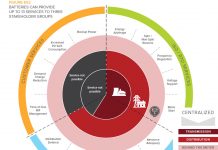by Joseph McCabe, PE
Walking into the 2014 Intersolar North America San Francisco exhibit it became apparent there was a story embedded in the products and services displayed on the three different floors of the Moscone Center West. The third floor of the exhibits was dominated by PV structure companies which have entered into a competitive blood bath since our last report. Dominating the first floor were Chinese PV manufacturers Jinko Solar (NYSE: JKS), Canadian Solar (NYSE: CSIQ), Trina Solar (NYSE: TSL) and Yingli (NYSE: YGE) all sharing the center exhibit space. Although Chinese solar is a popular topic due to newly imposed import duties, and the PV racking industry is highly competitive, the dominant story of this year’s event was storage which dominated both the conference and the second floor 2014 Intersolar NA exhibits. On-going storage side-sessions were held adjacent to the storage focused exhibits.
Storage Role in the PV Industry
Storage has become such a hot topic because consumer, commercial, industrial and utility PV installations can now benefit from electrical storage. Storage is important for maintaining consistent electrical output from PV due to clouds; enables PV systems to store energy in the morning for dispatching during later hours of the day when the sun has gone down, when the electricity is more valuable; and allows for other high value grid related support functions.
Storage is becoming more prevalent in today’s PV industry for at least two reasons: 1. Because of lower PV installation costs, there are more and more PV installations. Higher amounts of PV, and a higher percentage of PV on the grid requires storage to smooth out drops in PV power output due to clouds, called intermittency (especially important in isolated grids with lots of PV such as in Hawaii). 2. Lower electrical storage costs from batteries, driven by the electric automotive industry, are enabling lower costs and more functionality for PV combined with electrical storage. These factors combined with the now available advanced functionality from PV inverters are opening up new markets for storage. New policies, new electrical tariffs (the way utilities charge customers) and new storage use cases are creating profits for both the PV industry and the utilities. There are many different types of electrical storage which are used for different reasons, some of which are discussed in a previous article. The different kinds of storage will play out in the industry for their particular functionality, cost advantages and reliability.

Electrical storage requires integration with inverters; in a PV system an inverter with storage produces a more complete, reliable energy solution. Big industrial electronics players like ABB (NYSE: ABB, formerly Power-One inverters), EATON (NYSE: ETN), TMEIC, Bonfiglioli, Advanced Energy (NASDAQ: AEIS) and Solectria Renewables were exhibiting larger and larger inverter solutions including ones integrated with storage.


There were inverter company exhibits from Outback Power, SolarEdge, Chint Power and Magnum Energy. Kaco, Fronius and SMA (XETRA: S92.DE) have announced US consumer grid tied inverters integrated with electrical storage, similar to those currently offered in Europe. Those companies did not have exhibits but SMA did have a van parked outside displaying their smaller technologies.

Storage companies like Bosch Energy Storage, JuiceBox Energy, Ideal Power (NASDAQ: IPWR), Princeton Power Systems, Energy Toolbase, Sonnenbatterie GmbH, Hoppecke, Rolls Battery of New England, S&C Electric Company, VARTA Storage, American Vanadium (CVE: AVC.V) and Stem filled up a major portion of the second floor exhibit space.

Aquion Energy 7 kW, 22 kWh (at 20 hours and 30 degrees C) pallet of storage weighs 3,175 lbs and has a more than 3,000 cycle life. This particular technology doesn’t have chemical fire safety issues inherent with other technologies.
Vanadium redox batteries were discussed in sessions and displayed at this years exhibit. Vanadium redox is an interesting storage technology because in addition to the fast response time for dispatching electricity, it has an end of life value; vanadium is used for strengthening steel for rebar and other stronger, lighter materials when converted to ferrovanadium for use as a steel additive.
 Many policies are driving storage including California’s AB514, Self Generation Incentive Program, and Electric Program Investment Charge, ConEd’s Demand Management, NYSERDA PV Incentive and Reforming the Energy Vision, Massachusetts Community Resiliency Technical Assistance, New Jersey Storage Incentive, and Rule 21. If storage is positioned correctly with PV it can obtain the federal investment tax credit (ITC). Storage projects are beginning to be implemented with request for offers (RFO) and request for proposals (RFP) for storage at Hawaiian Electric Company (HECO), Southern California Public Power Authority (SCPPA), Southern California Edison (SCE) and Long Island Power Authority (LIPA).
Many policies are driving storage including California’s AB514, Self Generation Incentive Program, and Electric Program Investment Charge, ConEd’s Demand Management, NYSERDA PV Incentive and Reforming the Energy Vision, Massachusetts Community Resiliency Technical Assistance, New Jersey Storage Incentive, and Rule 21. If storage is positioned correctly with PV it can obtain the federal investment tax credit (ITC). Storage projects are beginning to be implemented with request for offers (RFO) and request for proposals (RFP) for storage at Hawaiian Electric Company (HECO), Southern California Public Power Authority (SCPPA), Southern California Edison (SCE) and Long Island Power Authority (LIPA).
Valuing Storage, Rule 21
What wasn’t being discussed very much at the 2014 Intersolar meeting and relates directly to storage was Rule 21. Rule 21 is the new utility tariff in California which will be driving the values from/for these electronics and storage solutions. July 18th 2014 is the current deadline for submission of new Rule 21 tariffs by the California Investor O
wned Utilities (IOUs) to the California Public Utilities Commission (CPUC). New functions including storage will be implemented, and paid for by these new tariffs.
The proposed first seven functions to be implemented by Rule 21 are Anti-Islanding Protection, Low and High Voltage Ride-Through, Low and High Frequency Ride-Through, Dynamic Volt-Var Operation, Ramp Rates, Fixed Power Factor and Soft Start Reconnection. Some of these functions enable greater PV on the grid, while others provide higher values from PV systems to the grid. Benefits to the utility from, for example, distributed power factor correction (reactive power correction) include but are not limited to increasing available grid capacities, reducing grid losses, and decreasing grid congestion. These functions help to set the stage for greater amounts of storage + PV on the grid. For example, Anti-Islanding Protection is needed if there are many storage units connected to PV systems. The communications for all these smart grid and advanced functions are being developed by industry players like SunSpec Alliance; communications are the second phase of Rule 21. Storage plays a dominant role in the third phase where scheduling of energy services will become implemented. All these phases will play out in California in the next few years.
Turn-key Storage Solutions
I particularly impressed by a company named Greensmith. They are currently a privately held company with a reported $14M private investment and offices in Maryland and California. The history of this company dates back to 2008 with software development. Finding it easier to do the front and back end hardware themselves they became a turnkey solution for grid support and energy storage. They have a chemistry-neutral battery management system which makes them relevant to the whole storage landscape. The functions being provided by Greensmith are finding utility markets with New Jersey’s PJM frequency response, New York’s energy arbitrage (example: pumped storage resources can arbitrage price by purchasing lower priced off-peak power and selling power during peak hours of the day along with demand management due to Indian Point shut down) and the previous mentioned California Rule 21 tariff. These functions also include ramp rate control, smoothing, peak shaving and capacity shifting. CEO John Jung provided a presentation to the sessions held at the Intercontinental. They have 30 systems installed at 9 utilities with experience in 8 batteries and 6 inverter technologies. The largest of which is a 20 MW turn-key system. Systems include a 500 kW / 1.5 MWh storage system in San Diego and EV Charge + PV in Brooklyn, NY and Honolulu, HI.

Conclusion
PV combined with storage is becoming more important in the PV industry because of lower costs and greater monetizable values for increased electrical services. Energy, demand, power factor and frequency response are just some of the utility values driving the increased attention for storage when combined with PV. Turn-key system solutions that address specific use cases for storage will be driving the near-term markets for grid connected storage in the PV industry.
Disclosure: No positions. Photos were taken before exhibits opened.
Joseph McCabe is an international solar industry expert with over 20 years in the business. He is a Solar Energy Society Fellow, a Professional Engineer, and is a recognized expert in developing new business models for the industry including Community Solar Gardens and Utility Owned Inverters. McCabe has a Masters Degree in Nuclear and Energy Engineering and a Masters Degree of Business Administration.
Joe is a Contributing Editor to Alt Energy Stocks and can be reached at energy [no space] ideas at gmail dotcom
This article was first published on AltEnergyStocks.com. Joe will attempt to answer any comments left on the original article [link].







